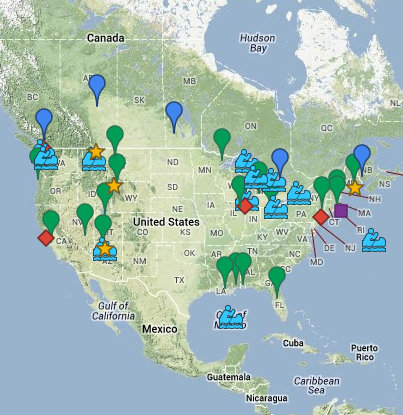Too many meetings; not enough beaches. Yesterday's meeting was at the Padilla Bay Reserve, however, so with sandwiches in hand a few of us walked down to the shore at lunch. Padilla Bay is an inactive portion of the much larger Skagit Delta - the Skagit River currently dumps all of its sediment into Skagit Bay between La Conner and Stanwood. Maybe because of the lack of fluvial sedimentation, the tidal flats of Padilla Bay are infested (maybe I should just say thick) with eelgrass (mainly zostera marina, some z. japonica). The bay is the largest single expanse of eelgrass in the Sound, although it is a bit unrepresentative of the narrow, fringing beds that characterize the steep, narrow platforms typical most everywhere else.
The gravel beaches along the edge of the bay are narrow and pretty low energy. As is typical of high-sediment areas around the margins of deltas, the transition from the steeper, gravelly foreshore to the fine-grained flats is pretty high - probably about mid-tide. On exposed beaches without big sediment loadings, the break is typically near MLLW. I suspect the original gravel beach probably extends down below the fine grained sediment and the eelgrass, though I haven’t actually checked. Presumably as the delta moved into the neighborhood, it basically buried the existing low tide terrace and lower intertidal gravel beach. If the river had stayed, or if it were to come back, the edge of the bay might all eventually turn to salt marsh as the delta front marched north.
This time of year, eelgrass can wash up in thick windrows along the beach – two distinct deposits were evident today, both hopping with amphipods and small flies.

2 comments:
have you observed any difference in the elevation of the HT/LT break (start of LTT) between the N and S SOund? Just curious about how the tidal regime effects beach topography...
I haven't noticed a systematic pattern, but that doesn't mean one may not exist. It's easer to see this relationship with abundant sediment supply since it occurs over short distances where complicating factors like tides and wave energy are relatively constant.
David Finlayson's dissertation looked at morphology at sites up and down the Sound and noted this influence. Megan Dethier's SCALE work samples near MLLW, which might also provide insight (this phenomenon may also confound their observations, since it means that sometimes they are sampling the lower beacface and sometimes they are sampling the low-tide terrace, depending on the elevation of the break).
Ultimately, someone should test the hypothesis that the elevation of the low tide break is related to local sediment input - and look at the elevations adjacent to large river deltas (Warm Beach-Stilliguamish?), small stream deltas (Dash Point SP?), and maybe a couple big landslides (Brownsville?).
Post a Comment